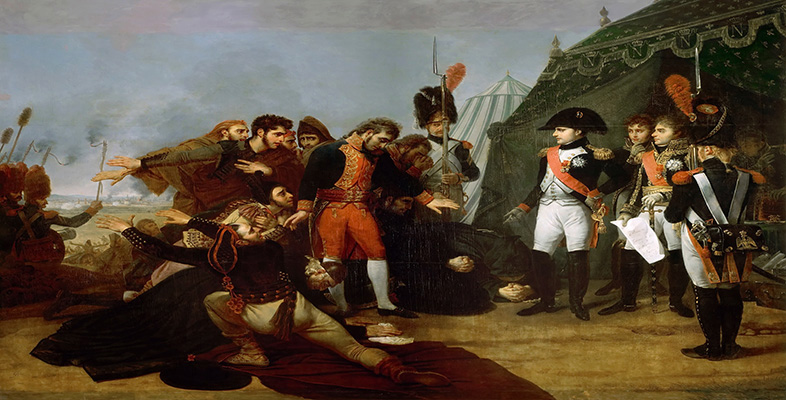2 The portrait of Napoleon
2.1 The general
Even early on, when he was a brilliant young general winning battles in Italy, Napoleon was already well aware of the value of images in promoting his career. It was not only owing to his own initiative that he had his portrait painted at this stage, but also because it was advantageous for an artist to be associated with a national hero. Gros, who had gone to Italy to pursue his studies as a history painter but found himself practising portraiture out of financial necessity, got himself introduced to Bonaparte's wife, Josephine, in 1796 ‘in the sole hope of getting to do the portrait of the general’ (quoted in O'Brien, 1995, p.653). In the resulting painting, General Bonaparte at the Bridge of Arcole (1797), he is shown leading a charge across a bridge (see Plate 5 [Tip: hold Ctrl and click a link to open it in a new tab. (Hide tip)] ). More famous than the actual painting, however, is the sketch for it, in which the loose brushwork enhances the overall dynamism of the image (see Plate 6). But even in the finished work there is a strong sense of movement that distinguishes it from the long-established tradition of military portraiture, which Gros took as his starting point, a tradition exemplified by Hyacinthe Rigaud's portraits of commanders (see Plate 5).
Click to see plate 5 Antoine-Jean Gros, General Bonaparte at the Bridge of Arcole, 1797, oil on canvas, 130 x 94 cm, Musée National du Château, Versailles. Photo: Bridgeman Art Library
Click to see plate 6 Antoine-Jean Gros Bonaparte at the Bridge of Arcole, 1796, oil sketch, 72 x 59 cm, Louvre, Paris. Photo: Bridgeman Art Library
Click to see plate 7 Hyacinthe Rigaud, Marshal Charles-Auguste de Matignon
Exercise
Compare Gros's portrait of Bonaparte (Plate 5) to Rigaud's of a French marshal (Plate 7). In what ways does Gros follow the model provided by Rigaud, and how does he alter it in order to convey a greater sense of movement? Consider, in particular, the type of portrait (full-length, half-length, etc.), the setting of the scene and the sitter's pose.
Discussion
Like Rigaud, Gros employs a three-quarter-length format, showing his sitter from just below the knees upwards, and with a battle going on in the background (though the battle is more implied than evident in the later work). However, the poses of each figure are very different. The marshal painted by Rigaud is not engaged in action but faces calmly frontwards, one hand resting on his sword hilt and the other gesturing towards the battle with his marshal's baton as a demonstration of his leadership. By contrast, Gros shows Bonaparte in the thick of battle, striding ahead while simultaneously looking back to rally his troops on. The twist in his body (torso facing to the right, head to the left) serves to animate the whole image. In addition, the waving flag that he holds aloft and his outstretched sword are both cut off at the edge of the picture, producing a sense that what we are seeing is a fleeting snapshot of an actual moment.
The overall result is a painting that is not a conventional portrait but has something of the character of a history painting, in so far as it depicts a decisive moment of military action. In fact, the event depicted by Gros was nothing of the kind since, although Bonaparte claimed to have successfully led a charge at Arcole, it actually took two more days' fighting before the French could cross the bridge. The story is typical of the way that Napoleon embroidered the truth for propaganda purposes throughout his career. His awareness of the value of good publicity is also evident from the fact that he paid to have Gros's portrait engraved (see Plate 8), thereby ensuring that it would reach a wide audience. The image that it conveys is of a brave commander who, by his example, inspires his men to follow him. Since he does not bother to look at the enemy, it is as if he knows his strategy in advance and is completely confident of victory. As such, he can be identified as a hero, a term which should be understood to mean a very particular kind of person who is certainly exceptional but perhaps not entirely admirable. This becomes apparent from the definition of ‘hero’ in the Encyclopédie, the great work of reference which embodies the rational, public-spirited and humanitarian ideals of the Enlightenment.
Click to see plate 8 Thomas Piroli, after Gros, General Bonaparte at the Bridge of Arcole, 1797, etching with aquatint, 72 x 59 cm, Bibliothèque Nationale de France, Paris
